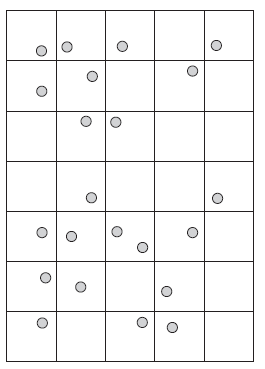The police have made arrests at the following locations:

Find the variance and the mean of the number of arrests per cell, and use the variance-mean ratio to test the hypothesis that the arrests are distributed randomly over the area (against the two-tailed hypothesis that they are not).
First we find the mean number of points per cell. There are 35 cells and 22 points, so that xmean = 22 / 35 = 0.629.
Next we find the variance of the number of points per cell:
s2 = (1/34) * ( (1 - 0.628)2 + (1 - 0.628)2 + (1 - 0.628)2 + (0 - 0.628)2 + (1 - 0.628)2 …)
s2 = (0.029) * (10.171) = 0.299
Next we calculate the VMR:
VMR = s2 / xmean = 0.299 / 0.629 = 0.476
Finally, we find the z value:
z = sqrt((m - 1) /2) (VMR - 1)
z = sqrt((35 - 1) /2) (0.476 - 1) = -2.161
With alpha equal to 0.05, the critical values are -1.96 and +1.96. The z-score is less than the critical value, so that we reject the null hypothesis of no pattern. The data imply spatial dispersion.
You might also like to view...
How does a greenhouse work, and why is the analogy of the earth's atmosphere to a greenhouse imperfect?
What will be an ideal response?
These clouds are often called "fair weather" clouds
cumulus stratus cirrus nimbo
Which of the following products made its way to Europe as part of the Columbian Exchange?
A) potatoes B) wheat C) horses D) grapes E) barley
Part of the environmental wisdom worldview proposes that success involves ____.
A. managing the earth's systems for ourselves B. managing the earth by dominating, changing, and managing the earth for everyone C. economic growth, development, better management, and technology D. learning how nature sustains itself and integrating this into our actions E. understanding nature to dominate, change, and manage it